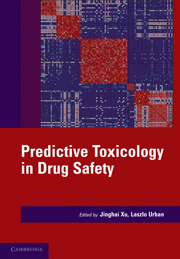Book contents
- Frontmatter
- Contents
- Contributors
- Prologue – Predictive toxicology: a new chapter in drug safety evaluation
- PREDICTIVE TOXICOLOGY IN DRUG SAFETY
- I SPECIFIC AREAS OF PREDICTIVE TOXICOLOGY
- 1 The human predictive value of combined animal toxicity testing: current state and emerging approaches
- 2 Screening approaches for genetic toxicity
- 3 Cardiac safety
- 4 Predicting drug-induced liver injury: safer patients or safer drugs?
- 5 In vitro evaluation of metabolic drug–drug interactions
- 6 Reliability of reactive metabolite and covalent binding assessments in prediction of idiosyncratic drug toxicity
- 7 Immunotoxicity: technologies for predicting immune stimulation, a focus on nucleic acids and haptens
- 8 Predictive models for neurotoxicity assessment
- 9 De-risking developmental toxicity-mediated drug attrition in the pharmaceutical industry
- II INTEGRATED APPROACHES OF PREDICTIVE TOXICOLOGY
- Epilogue
- Index
- Plate section
- References
9 - De-risking developmental toxicity-mediated drug attrition in the pharmaceutical industry
from I - SPECIFIC AREAS OF PREDICTIVE TOXICOLOGY
Published online by Cambridge University Press: 06 December 2010
- Frontmatter
- Contents
- Contributors
- Prologue – Predictive toxicology: a new chapter in drug safety evaluation
- PREDICTIVE TOXICOLOGY IN DRUG SAFETY
- I SPECIFIC AREAS OF PREDICTIVE TOXICOLOGY
- 1 The human predictive value of combined animal toxicity testing: current state and emerging approaches
- 2 Screening approaches for genetic toxicity
- 3 Cardiac safety
- 4 Predicting drug-induced liver injury: safer patients or safer drugs?
- 5 In vitro evaluation of metabolic drug–drug interactions
- 6 Reliability of reactive metabolite and covalent binding assessments in prediction of idiosyncratic drug toxicity
- 7 Immunotoxicity: technologies for predicting immune stimulation, a focus on nucleic acids and haptens
- 8 Predictive models for neurotoxicity assessment
- 9 De-risking developmental toxicity-mediated drug attrition in the pharmaceutical industry
- II INTEGRATED APPROACHES OF PREDICTIVE TOXICOLOGY
- Epilogue
- Index
- Plate section
- References
Summary
INTRODUCTION: THE BUSINESS NEED FOR IN VITRO TESTS
Each year, the pharmaceutical industry synthesizes thousands of novel chemical entities with an array of biological activities; however, only a small fraction will make it to market due to poor efficacy or toxicity concerns. Although the drug candidate attrition rate will always be high, the key determinant of its economic consequence is whether it occurs early or late in product development. This point is particularly poignant with respect to developmental toxicity because the first indication of teratogenicity is at the time of the regulatory compliant embryo/fetal toxicity study, which is generally conducted relatively late in drug development, at the transition from Phase II to Phase III. So even though it has been estimated that only about 7 percent of pharmaceutical attrition is due to reproductive and developmental toxicity concerns (about 3.5 percent to developmental toxicity alone), the significant investment of time and money to this point makes such failures catastrophic. Thus, a key challenge is the early identification and management of developmental toxicity risks prior to the conduct of pivotal in vivo embryo/fetal toxicity studies. For the purposes of this chapter, there are three aspects to meeting this challenge. The first is the assessment of the inherent risk of the therapeutic target. How important is the target during embryogenesis and what are the consequences of modulating its activity?
- Type
- Chapter
- Information
- Predictive Toxicology in Drug Safety , pp. 153 - 182Publisher: Cambridge University PressPrint publication year: 2010
References
- 1
- Cited by



